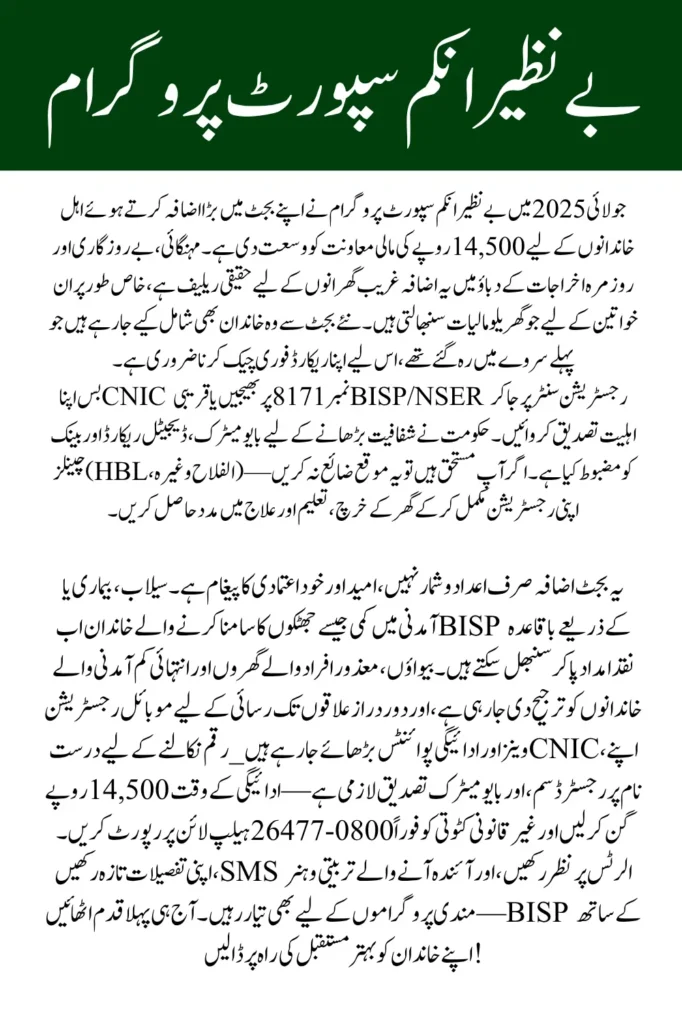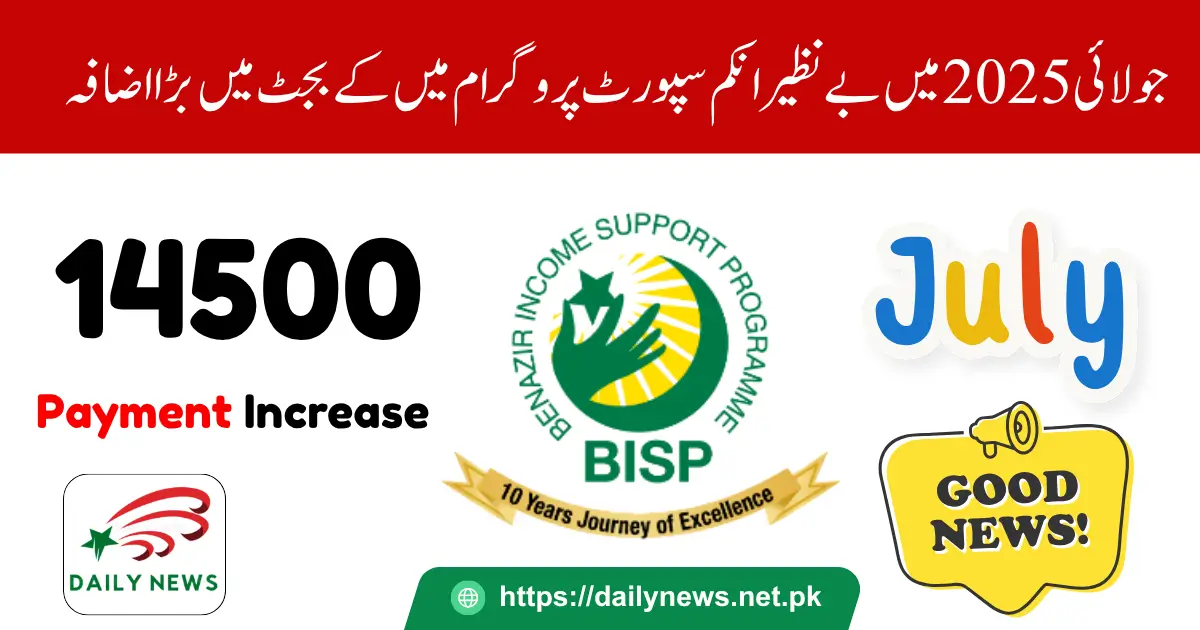For millions of impoverished Pakistani families, the BISP Increases Budget 14500 July 2025 has been a lifeline. In 2025, BISP has announced a major increase in its budget, which means more families across Pakistan will now have access to financial assistance. This is huge news, especially for those living below
For millions of impoverished Pakistani families, the BISP Increases Budget 14500 July 2025 has been a lifeline. In 2025, BISP has announced a major increase in its budget, which means more families across Pakistan will now have access to financial assistance. This is huge news, especially for those living below
For millions of impoverished Pakistani families, the BISP Increases Budget 14500 July 2025 has been a lifeline. In 2025, BISP has announced a major increase in its budget, which means more families across Pakistan will now have access to financial assistance.
This is huge news, especially for those living below the poverty line in both rural and urban areas. The government’s decision to expand the BISP budget shows a commitment to reducing poverty and helping the most vulnerable communities. But what does this mean for the average Pakistani family?

The BISP programme, named after the late Prime Minister Benazir Bhutto, was launched to provide cash transfers to low-income families. With this new budget increase, BISP aims to cover more households, ensuring that families who were previously left out can now benefit. The programme targets women as the primary recipients, empowering them to manage household finances and improve their family’s quality of life. If you’re wondering whether your family qualifies or how this budget increase will affect you, keep reading. We’ll cover all the details, from eligibility to the application process.
Also Read More: Easy Way to Withdraw BISP 13500 Cash Without Any Problem Latest Update
Why the BISP Budget Increase Matters
Rising inflation, unemployment, and unexpected crises like floods or health emergencies can push families into financial hardship. The BISP budget increase is a game-changer because it means more people will receive monthly stipends to help cover basic needs like food, education, and healthcare. This isn’t just about handing out money, it’s about giving families a chance to stabilize their lives and plan for a better future.
For example, imagine a family in a small village in Sindh where the breadwinner lost their job due to factory closures. With BISP’s financial support, the mother can now afford to send her kids to school or buy medicines for an elderly family member. The increased budget allows BISP to reach more families like this, especially in far-flung areas of Balochistan, Khyber Pakhtunkhwa, and Punjab, where poverty rates are high. The programme also plans to introduce skill development initiatives, so families can eventually become self-sufficient.
This expansion isn’t just about numbers, it’s about hope. More families will now have a safety net, and that’s something every Pakistani can feel proud of. The government has also promised to make the process transparent, so the aid reaches those who need it most. But how do you know if you’re eligible, and how can you apply? Let’s dive into the details.
Who Can Benefit from BISP’s Expanded Programme?
The BISP budget increase means the programme is now open to more families, but there are specific criteria to qualify. The programme is designed for the poorest of the poor, so it prioritizes households with limited income and resources. If you’re wondering whether your family can apply, here’s a clear explanation of who qualifies and how the process works.
BISP uses a Poverty Scorecard Survey, also called the National Socio-Economic Registry (NSER), to determine eligibility. This survey looks at your household’s income, assets, and living conditions. Families with a score below a certain threshold (usually indicating extreme poverty) are selected for the programme. The good news? With the budget increase, BISP is conducting fresh surveys to include more households, especially those who may have been overlooked in the past.
The programme primarily targets women, as they are often the ones managing household expenses. If you’re a woman living in a low-income household, you’re likely eligible to apply. Widows, single mothers, and families with disabled members are given priority. The cash transfers are usually deposited directly into the recipient’s bank account or delivered through biometric-enabled ATMs, making it easy and secure to access the funds.
Also Read : BISP July 2025 Payment Start For All Beneficries
How to Apply for BISP in 2025
Applying for BISP is straightforward, but it requires some preparation. The process is designed to be accessible, even for people in remote areas. If you think your family qualifies, here’s what you need to do:
- Visit a BISP Registration Center: Find the nearest BISP office or registration camp in your area. These are set up in every district, and mobile teams often visit rural areas to make registration easier.
- Complete the NSER Survey: A BISP representative will ask you questions about your household’s income, expenses, and living conditions. Be honest and provide accurate details to ensure your application is processed correctly.
- Submit Required Documents: You’ll need to provide some basic documents (listed below) to verify your identity and eligibility.
- Await Approval: Following the completion of your survey, BISP will examine your application; if it is accepted, you will be notified and given information regarding the payment schedule and method.
- Collect Your Payments: Payments are usually made monthly or quarterly, either through a bank account or a biometric ATM. You’ll need to verify your identity each time you collect the funds.
The budget increase means BISP is setting up more registration centers and mobile units, so even families in remote areas can apply without traveling long distances. If you’re unsure about the process, you can also call the BISP helpline (0800-26477) for guidance.
Documents You’ll Need to Apply
To make the application process smooth, make sure you have the following documents ready:
- CNIC (Computerized National Identity Card): The woman applying must have a valid CNIC. If you don’t have one, visit a NADRA office to get it issued.
- Proof of Household Members: Provide CNICs or B-Forms (for children) of all family members living in your household.
- Income Details: If possible, bring any proof of income, like a salary slip or a letter from your employer. If you don’t have formal income, the survey will assess your situation.
- Utility Bills (Optional): Electricity or gas bills can help verify your address and living conditions.
- Disability Certificate (if applicable): If a family member is disabled, a certificate from a government hospital or authority can help prioritize your application.
Also Read More : BISP Kafaalat Phase 3 – July 2025 Payments
Where to Go for BISP Registration
BISP has made it easier for families to register by setting up offices and camps across Pakistan. Here’s where you can go:
- District BISP Offices: Every district has a BISP office.To locate the nearest one, visit the official BISP website (www.bisp.gov.pk) or give the helpline a call.
- Mobile Registration Vans: These vans travel to rural and remote areas, especially in Balochistan and KPK, to conduct surveys on the spot.
- Tehsil-Level Camps: Temporary registration camps are often set up at the tehsil level during enrollment drives. Keep an eye on local announcements or newspapers for updates.
- Partner Banks: Some banks, like HBL and Alfalah, have BISP payment counters where you can inquire about the programme while collecting payments.
Challenges and How BISP is Addressing Them
While the BISP budget increase is a positive step, there are still challenges. Some families in remote areas may struggle to reach registration centers, and others may not have the required documents. There have also been concerns about transparency in the past, with reports of ineligible people receiving funds. The good news is that BISP is taking steps to fix these issues.
For example, the programme is now using advanced technology, like biometric verification, to ensure payments go to the right people. The budget increase also allows BISP to hire more staff and train them to conduct surveys fairly. If you face any issues during the application process, don’t hesitate to report them to the BISP helpline or visit a local office for assistance. The programme is committed to making sure every deserving family gets help.
What’s Next for BISP Beneficiaries?
The budget increase is just the beginning. BISP plans to roll out additional programmes, like vocational training and interest-free loans, to help families move out of poverty permanently. These initiatives will focus on teaching skills like tailoring, computer literacy, and small business management. For now, the focus is on getting as many eligible families enrolled as possible.
If you’re already a BISP beneficiary, you might see an increase in your monthly stipend, depending on the new budget allocations. Keep your CNIC and contact details updated with BISP to avoid any delays in payments. For new applicants, the key is to act fast and visit a registration center as soon as possible to get your survey done.
Conclusion
The BISP budget increase is a golden opportunity for struggling families to get the support they need. If you think you qualify, don’t wait to gather your documents, visit a BISP registration center, and get your survey done.It’s worthwhile to verify your eligibility even if you’re not sure.This programme is here to help, and with the expanded budget, more Pakistani families than ever can benefit. Let BISP be your partner in creating a better future by taking the first step right now!
FAQs
Who is eligible for BISP in 2025?
Women from low-income households with a poverty scorecard below the threshold qualify. Priority is given to widows, single mothers, and families with disabled members.
In what amount will I receive from BISP?
The amount varies, but most families receive a monthly or quarterly stipend to cover basic needs. Check with your local BISP office for the latest figures.
Can men apply for BISP?
BISP primarily targets women as recipients, but men can provide household details during the survey if they’re part of an eligible family.
What if I don’t have a CNIC?
You’ll need a valid CNIC to apply. Visit a NADRA office to get one issued before starting the BISP registration process.
How do I know if my application is approved?
Your registered phone number will receive a confirmation message from BISP. You can also check your status by calling the BISP helpline (0800-26477).
